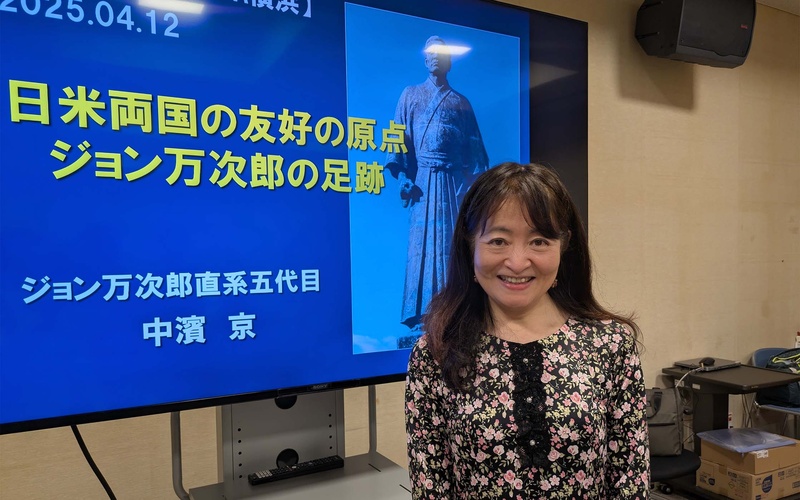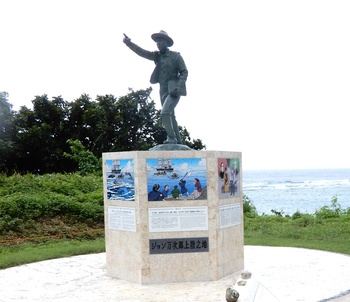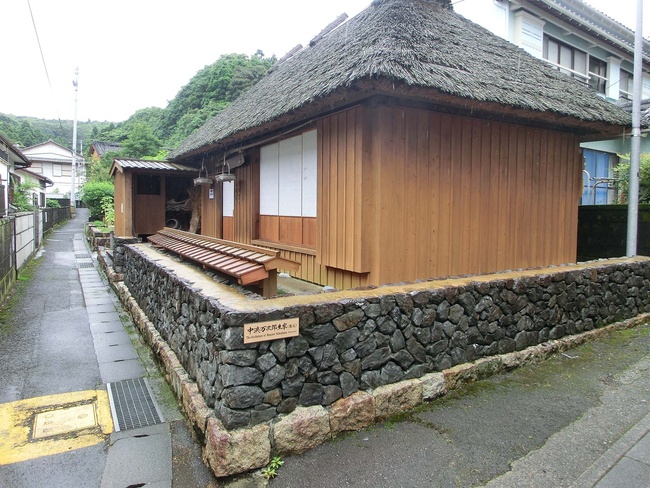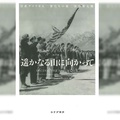An extraordinary life story and achievements
While there are many immigrants and migrants who traveled abroad of their own volition to carve out a new life for themselves, there are also those who ended up in a foreign land by chance after being cast away at sea and lived a life they never imagined. A typical example of this is John Manjiro (Nakahama Manjiro), who was rescued by an American whaling ship while cast away at sea in the late Edo period and made his way to the American mainland, where he later devoted himself to promoting exchanges and friendship between Japan and the United States.
On April 12th at JICA Yokohama, Ms. Kyo Nakahama, a fifth-generation direct descendant of John Manjiro, gave a lecture entitled "John Manjiro - The Origin of Friendship between Japan and the United States" (co-hosted by the Immigration Research Group and the JICA Yokohama Overseas Migration Museum) about the life and character of John Manjiro, who is known as the first Japanese person to land on the American continent, and the role he played in Japan-U.S. relations.
As Manjiro is a famous historical figure, the lecture was packed with people far exceeding the capacity of 40, including immigration researchers and history buffs. Before the lecture began, singing could be heard in the hall. When it was introduced as "In the Name of Brotherhood (In the Spririt of John Manjiro)," a song about Manjiro by the old American folk group, The Brothers Four, some in the hall exclaimed, "There was a song like that?"
Taking to the stage, Nakahama Kyo first spoke about the life of her ancestor John Manjiro, who led a very unusual life, chronologically, citing documents remaining in the Nakahama family home.
Following in Manjiro's footsteps based on the lecture...
Manjiro was born in 1827 in Nakahama, Cape Ashizuri, on the southwestern tip of Kochi Prefecture. He lost his father at the age of nine and began working as a fisherman early on to help support his family. In 1841, at the age of 14, he went out fishing with his brothers and five friends, but was swept away by the Kuroshio Current and drifted away. In most cases, such a situation would result in the fishermen being carried north to Kamchatka, but this year the Kuroshio Current was meandering, and Manjiro and his friends were washed ashore on Torishima Island to the southeast.
Torishima was also a place where many Japanese ships had washed ashore. Manjiro and his crew survived by eating albatrosses, and 143 days after being stranded, they were rescued by the American whaling ship John Howland. Captain Whitfield dropped the four men off in Hawaii, but when he asked Manjiro to go to America, he accepted, and in May 1843, they disembarked at the ship's home port of New Bedford, Massachusetts.
The captain sent Manjiro to board at his home in Fairhaven, next to New Bedford, and sent him to school. Manjiro studied hard and went on to the best school in town, where he studied advanced mathematics and navigation. The captain, a devout Christian, also sent Manjiro to church. At first, he took Manjiro to the church the captain attended, but when he was discriminated against because he was not white, the captain became indignant and decided to send Manjiro to a Unitarian church, which would accept him.
In May 1846, at the age of 19, Manjiro was invited to leave New Bedford on a whaling ship called the Franklin. During the voyage, he met up with old companions in Hawaii, but was unable to return to Japan, which was under national isolation, so he continued whaling before returning to New Bedford in September 1849.
That year, Manjiro aimed to return to Japan, and in order to earn money, he worked in a gold mine near Sacramento, California, which was booming at the time during the Gold Rush, and obtained some funds. He set sail from San Francisco in September 1850, and on the way he met an old friend in Hawaii. He took the two of them to Japan, and, eager to see his mother, he landed in the southern part of what is now Okinawa's main island in 1851, even though he knew he would face a serious crime.
After being investigated for long periods by the Satsuma Domain, which governed the Ryukyu Islands (Okinawa), and the Nagasaki Magistrate's Office, Manjiro was finally able to meet his mother in his hometown of Tosa for the first time in 12 years in 1853. Manjiro's grave had already been built by this time.
Later, in the Tosa domain, Koryu Kawada compiled the four-volume "Hyosun Kiryaku" based on what he had heard from Manjiro about the American situation. This work influenced many samurai of the domain. Manjiro also taught English at the domain school.
Perry arrived in Uraga in 1853 and was due to return the following year, so Manjiro was summoned by the shogunate to go to Edo to inform them of the situation in America. He also prepared to serve as an interpreter for Perry, but was suspected of being a spy and this did not come to fruition.
In 1860, Manjiro served as an interpreter on the Kanrin Maru, an escort ship for the Bouhatan, which was carrying a Japanese mission to America. After arriving in America, he visited Fairhaven, where he had once lived, and was reunited with his benefactor, Captain Whitfield, for the first time in 20 years. Manjiro, who influenced many of the leading figures who would later lead the Meiji Restoration, passed away in 1898 at the age of 71.
Manjiro connected people with friendship
This is a brief overview of Manjiro's life, but looking back, it is no exaggeration to say that his encounter with Captain Whitfield determined the rest of his life. Without the support of the captain when Manjiro was shipwrecked and had nothing but the clothes on his back, he would never have gone from being a fisherman to becoming the man who forged ties with America.
Speaking of something that has been passed down in the Nakahama family, Kyo Nakahama emphasizes, "What we learned from Captain Whitfield is the importance of loving our neighbors."
After Manjiro passed away, the Nakahama family and the Whitfield family began to have a relationship that has continued through the postwar period to the present day, spanning five generations. In 1940, just before the outbreak of war between Japan and the United States, the fourth generation Whitfield family and Commodore Perry's grandson came to Japan on a special mission from President Roosevelt, and three families, including the Nakahama family, gathered together.
Nakahama's words, "During the war, the Whitfield family seemed to be very worried about the Nakahama family," show the friendly relationship that transcends national boundaries.
Regarding the Nakahama family, which has been honoring their immigrant ancestors for generations and building friendly relations with overseas countries, Yanagisawa Ikumi (part-time lecturer at Nanzan University), who organized the lecture and served as moderator, said, "I can't think of any other examples. I think their connection with Captain Whitfield is a big factor. They also have ongoing contact with the descendants of Commodore Perry and the descendants of Reverend Damon, who helped Manjiro and his companions in Hawaii. It may be that it is these connections between people that make continued honoring activities possible."
A universal thinker
In addition to his encounter with Captain Whitfield, Manjiro's own talent, hard work, and personality also opened up new possibilities for his life in Japan at that time. Based on his research in Fairhaven, Massachusetts, where Manjiro lived, in March last year, Yanagisawa said that Manjiro was "an extremely curious and adaptable boy, and above all, a man of universal thought who could connect with anyone as a human being." He cited his experiences on the seas aboard a whaling ship and the influence of the Unitarian Church, which advocated egalitarianism and pacifism, as factors that led to this belief.
In 1992, the John Manjiro Whitfield Memorial International Grassroots Center (CIE) was established as a foundation for John Manjiro, and the foundation has been carrying out activities aimed at promoting mutual understanding and friendship between the citizens of Japan and the United States, such as holding the Japan-U.S. Grassroots Exchange Summit.
There is a John Manjiro Museum in Tosashimizu City, and the Whitfield-Manjiro Friendship Memorial Hall1 in Fairhaven, and so commemorations are being made at the grassroots level in both Japan and the United States.
In 2027, it will be the 200th anniversary of Manjiro's birth, and materials are being organized and compiled into a database. There are many things written about Manjiro, but at the citizen level, there is currently a movement in both Japan and the United States to make a movie about Manjiro's life, and there are ongoing calls for "John Manjiro to be featured in the NHK Taiga drama." It will be interesting to see how this unique life will be portrayed in the world.
Notes:
1. The Whitfield-Manjiro Friendship Museum is introduced by Yanagisawa in Small Museums in North America 4: A World Heritage of Knowledge (Sairyusha).
© 2025 Ryusuke Kawai














